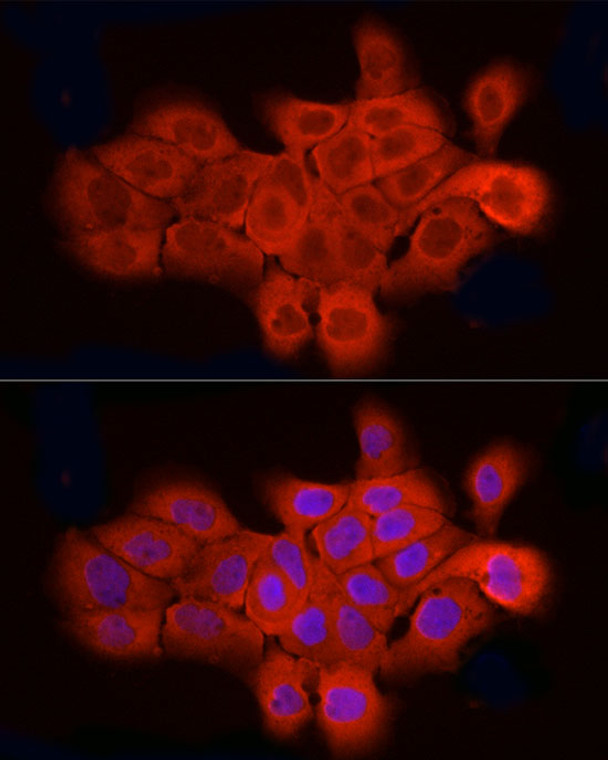| Host: |
Rabbit |
| Applications: |
WB/IF |
| Reactivity: |
Human/Mouse/Rat |
| Note: |
STRICTLY FOR FURTHER SCIENTIFIC RESEARCH USE ONLY (RUO). MUST NOT TO BE USED IN DIAGNOSTIC OR THERAPEUTIC APPLICATIONS. |
| Short Description: |
Rabbit polyclonal antibody anti-ELOVL4 (1-100) is suitable for use in Western Blot and Immunofluorescence research applications. |
| Clonality: |
Polyclonal |
| Conjugation: |
Unconjugated |
| Isotype: |
IgG |
| Formulation: |
PBS with 0.01% Thimerosal, 50% Glycerol, pH7.3. |
| Purification: |
Affinity purification |
| Dilution Range: |
WB 1:100-1:500IF/ICC 1:50-1:200 |
| Storage Instruction: |
Store at-20°C for up to 1 year from the date of receipt, and avoid repeat freeze-thaw cycles. |
| Gene Symbol: |
ELOVL4 |
| Gene ID: |
6785 |
| Uniprot ID: |
ELOV4_HUMAN |
| Immunogen Region: |
1-100 |
| Immunogen: |
A synthetic peptide corresponding to a sequence within amino acids 1-100 of human ELOVL4 (NP_073563.1). |
| Immunogen Sequence: |
MGLLDSEPGSVLNVVSTALN DTVEFYRWTWSIADKRVENW PLMQSPWPTLSISTLYLLFV WLGPKWMKDREPFQMRLVLI IYNFGMVLLNLFIFRELFMG |
| Tissue Specificity | Expressed in the retina and at much lower level in the brain. Ubiquitous, highest expression in thymus, followed by testis, small intestine, ovary, and prostate. Little or no expression in heart, lung, liver, or leukocates. |
| Post Translational Modifications | N-glycosylated. |
| Function | Catalyzes the first and rate-limiting reaction of the four reactions that constitute the long-chain fatty acids elongation cycle. This endoplasmic reticulum-bound enzymatic process allows the addition of 2 carbons to the chain of long- and very long-chain fatty acids (VLCFAs) per cycle. Condensing enzyme that catalyzes the synthesis of very long chain saturated (VLC-SFA) and polyunsaturated (PUFA) fatty acids that are involved in multiple biological processes as precursors of membrane lipids and lipid mediators. May play a critical role in early brain and skin development. |
| Protein Name | Elongation Of Very Long Chain Fatty Acids Protein 43-Keto Acyl-Coa Synthase Elovl4Elovl Fatty Acid Elongase 4Elovl Fa Elongase 4Very Long Chain 3-Ketoacyl-Coa Synthase 4Very Long Chain 3-Oxoacyl-Coa Synthase 4 |
| Database Links | Reactome: R-HSA-75876 |
| Cellular Localisation | Endoplasmic Reticulum MembraneMulti-Pass Membrane Protein |
| Alternative Antibody Names | Anti-Elongation Of Very Long Chain Fatty Acids Protein 4 antibodyAnti-3-Keto Acyl-Coa Synthase Elovl4 antibodyAnti-Elovl Fatty Acid Elongase 4 antibodyAnti-Elovl Fa Elongase 4 antibodyAnti-Very Long Chain 3-Ketoacyl-Coa Synthase 4 antibodyAnti-Very Long Chain 3-Oxoacyl-Coa Synthase 4 antibodyAnti-ELOVL4 antibody |
Information sourced from Uniprot.org
12 months for antibodies. 6 months for ELISA Kits. Please see website T&Cs for further guidance











